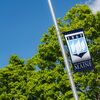Greater Portland transit agencies roll out draft plan to boost ridership
 Courtesy / Nelson/Nygaard Consulting Associates Inc.
The Transit Together plan calls for a high-frequency corridor on Congress Street, allowing for faster connections between routes and greater mobility on the peninsula.
Courtesy / Nelson/Nygaard Consulting Associates Inc.
The Transit Together plan calls for a high-frequency corridor on Congress Street, allowing for faster connections between routes and greater mobility on the peninsula.
Better connections between transportation hubs and more frequent service were among the top recommendations recently adopted by seven public transportation agencies in Southern Maine.
The agencies on Jan. 26 adopted a plan to serve as a roadmap for future investment in public transportation, attract new riders and improve the system. The plan was developed by the agencies and other regional stakeholders working with a team of consultants and regional planners.
The agencies working in tandem are Biddeford-Saco-Old Orchard Beach Transit, Casco Bay Lines, Greater Portland METRO, Northern New England Passenger Rail Authority, Regional Transportation Program, South Portland Bus Service and York County Community Action Corp.
The plan, called Transit Together, aims to be a coordinated strategy for improving the region's public transportation system. Recommendations call for:
- More direct connections between major transportation hubs, including the Portland Transportation Center, Monument Square and the Casco Bay Lines ferry terminal.
- More frequent service to places where demand is high or growing, such as Portland's eastern waterfront.
- A high-frequency corridor on Congress Street, allowing for faster connections between routes and services and greater mobility up and down the peninsula.
- Focusing on areas where there's a higher need for mass transit, including more frequent routes serving people who are heavily reliant on transit in high-density areas of South Portland.
- Faster and more direct bus routes that are easier to understand, including a redesigned network of fast and direct routes serving South Portland, Biddeford, Saco and Old Orchard Beach.
- Enhanced coordination among agencies, including a unified regional transit brand, improved accessibility at transit stops and hubs, and integrated technology systems to improve riders' ability to access information and plan their trip.
- Better connections among transportation services, including to the Portland Jetport, Amtrak Downeaster, intercity buses and Casco Bay Lines ferries.
"The region’s transit network has undergone incremental, individual agency-led changes over the past several decades, which inevitably contributes to some level of fragmentation,” said Andrew Clark, transit program manager at the Greater Portland Council of Governments. “The plan reimagines the entire system, helping us provide better service to existing riders, attracting new riders and creating a seamless and convenient experience for travel throughout the region.”
Before the pandemic, the region’s transit providers carried about 16,500 passengers per day.
According to background research:
- Some places in the region could support more frequent service, which has been shown to increase ridership.
- Some places have bus service that very few people use, while other places have service that isn’t frequent enough to meet the community’s needs. Matching service to demand will increase ridership. Implementing targeted solutions like micro-transit service is another form of matching service to demand.
- Some bus routes in the region change their routes depending on the time of day and/or operate in places people wouldn’t expect to see a bus. Making bus routes easier to understand generally attracts more riders.
- Many parts of the bus network are confusing and operate in large loops that force passengers to ride in the wrong direction for long periods of time to get where they’re going. Improving the network can help bus riders get where they’re going more quickly and reliably.
- The quality of bus stops varies dramatically by route. Some stops have shelters and benches, while others are missing simple items like signs and sidewalks. Improving bus stops would likely increase ridership.
The next step is for the transit agencies’ governing bodies to approve the recommendations.
Implementation could take many months. Some of the changes would require additional planning, public outreach and design work.
Some recommended improvements, such as higher-frequency service, higher-quality bus stops, and service to new places, would require additional funding from federal, state, regional, or local governments. The plan calls for the transit agencies to work together with local and regional governments to explore options for additional funding.
The report was developed over an 18-month period by the transit providers, Greater Portland Council of Governments, and a team of consultants led by Nelson\Nygaard, a transportation planning firm headquartered in Oakland, Calif., with an office in Boston.
“The recommendations in the final report would have considerable impacts for transit riders and the community at large,” said Chad Heid, executive director of Biddeford-Saco-Old Orchard Beach Transit.
Greg Jordan, executive director of Greater Portland METRO, said the recommendations, if implemented, would improve connections to transit hubs, add service to some underserved routes, and create a high-frequency corridor along Congress Street and Washington Avenue, allowing travel through Portland with wait times of less than 10 minutes.
To view the final report, still in draft form and subject to change, click here.










0 Comments